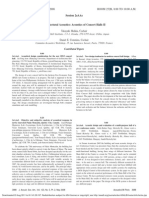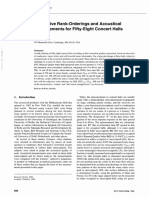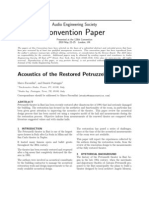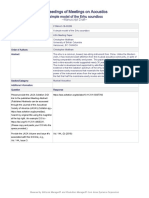Some Objective and Subjective Aspects of Three Acoustically Variable Halls
Some Objective and Subjective Aspects of Three Acoustically Variable Halls
Uploaded by
snailbookCopyright:
Available Formats
Some Objective and Subjective Aspects of Three Acoustically Variable Halls
Some Objective and Subjective Aspects of Three Acoustically Variable Halls
Uploaded by
snailbookOriginal Title
Copyright
Available Formats
Share this document
Did you find this document useful?
Is this content inappropriate?
Copyright:
Available Formats
Some Objective and Subjective Aspects of Three Acoustically Variable Halls
Some Objective and Subjective Aspects of Three Acoustically Variable Halls
Uploaded by
snailbookCopyright:
Available Formats
Applied Acoustics 35 (1992) 221-231
Some Objective and Subjective Aspects of Three
Acoustically Variable Halls
Rein Pirn
Acentech Incorporated, 125 Cambridge Park Drive, Cambridge, Massachusetts 02140, USA
(Received 17 July 1991; accepted 19 September 1991)
A BSTRA C T
The acoustics o f three contemporary concert~recital halls were investigated
by measurement and calculation, and by asking users to comment on the
perceived acoustical qualities. A II three halls, designed for the organ as well as
for other sources of music, are acoustically variable by means of large
retractable curtains. Variations in the measured R T together with the halls'
physical properties are used as the basis for estimating variability in some of
the newer acoustical measures. The results are compared with those for the
Vienna Musikvereinssaal and discussed in light o f user experiences.
INTRODUCTION
Virtually every serious organist wants a hall with a/3-£ reverberation time,
which is considered too reverberant for most other types of music. As it is
highly impractical to build halls for the exclusive enjoyment of organ music,
some form of acoustical variability must be incorporated in the design. This
paper explores the physical and acoustical properties of three somewhat
similar halls, all equipped with retractable curtains, that appear to have
more than met user expectations.
T H E HALLS
The three halls discussed in this paper are the Barrus Concert Hall at Ricks
College, Rexburg, Idaho (designed 1975-77, opened 1980); the Broyhill
221
Applied Acoustics 0003-682X/92/$05.00 © 1992 Elsevier Science Publishers Ltd, England.
Printed in Great Britain
You might also like
- Concert Halls and Opera Houses Music Acoustics and Architecture 1441930388Document661 pagesConcert Halls and Opera Houses Music Acoustics and Architecture 1441930388dejanyogi89% (9)
- Auditorium Acoustic Design: 30 Years, 15 Projects: Rob HarrisDocument7 pagesAuditorium Acoustic Design: 30 Years, 15 Projects: Rob HarrisS Muneer HussainNo ratings yet
- Bridgewater HallDocument4 pagesBridgewater HallHuzaifa J AhmedabadwalaNo ratings yet
- Acoustics in Architectural Design.Document507 pagesAcoustics in Architectural Design.Iulia Ion100% (3)
- Acoustic of Concert HallsDocument6 pagesAcoustic of Concert Hallshmaddy3117No ratings yet
- Aula Magna de La Ciudad Universitaria de CaracasDocument5 pagesAula Magna de La Ciudad Universitaria de CaracasAlina BalanNo ratings yet
- Sailaway The Sailing Simulator Crack Serial KeyDocument3 pagesSailaway The Sailing Simulator Crack Serial Keysnailbook100% (1)
- Concert Hall Acoustics - L.beraNEKDocument13 pagesConcert Hall Acoustics - L.beraNEKanandalaharNo ratings yet
- Theatre in Round ProblemsDocument2 pagesTheatre in Round ProblemsverNo ratings yet
- JAS000S13Document1 pageJAS000S13David MoyerNo ratings yet
- L & R PronunciationDocument265 pagesL & R PronunciationdooblahNo ratings yet
- Recent Developments in Soundproof DoorsDocument2 pagesRecent Developments in Soundproof DoorsNandaNo ratings yet
- Acoustics in ArchitectureDocument12 pagesAcoustics in ArchitectureArcNo ratings yet
- 225 SaggiatoreMusicale 2006Document16 pages225 SaggiatoreMusicale 200622510100886No ratings yet
- The Acoustics of Roofed Ancient Odeia: The Case of Herodes Atticus OdeionDocument10 pagesThe Acoustics of Roofed Ancient Odeia: The Case of Herodes Atticus OdeionGauri ChoudhariNo ratings yet
- Applied Acoustics: Mike Barron, Sven KissnerDocument1 pageApplied Acoustics: Mike Barron, Sven KissnersnailbookNo ratings yet
- Auditorium Acoustics Paris 2015 Evan GreenDocument9 pagesAuditorium Acoustics Paris 2015 Evan GreenMarvelouz Kate AbarioNo ratings yet
- Acoustical Design of The Tokyo Opera City (Toc) Concert Iball, JapanDocument2 pagesAcoustical Design of The Tokyo Opera City (Toc) Concert Iball, JapanM.A. YahyaNo ratings yet
- Subjective Rank-Orderings and Acoustical M - Leo BeranekDocument15 pagesSubjective Rank-Orderings and Acoustical M - Leo BeranekcrisNo ratings yet
- The Study of The Proscenium Area in An Opera House: Anna Sygulska, Krzysztof BRAWATADocument12 pagesThe Study of The Proscenium Area in An Opera House: Anna Sygulska, Krzysztof BRAWATAsomeonetookthisNo ratings yet
- Thesis On Acoustics in Architectural DesignDocument507 pagesThesis On Acoustics in Architectural DesignMo MaxNo ratings yet
- Auditorium Acoustics: ReferencesDocument32 pagesAuditorium Acoustics: ReferencesRamin amiriNo ratings yet
- Dolby The X-Curve SMPTE JournalDocument24 pagesDolby The X-Curve SMPTE JournalRichard DavidsonNo ratings yet
- Design of AmphitheaterDocument30 pagesDesign of AmphitheaterAditiNo ratings yet
- Acoustic ImpedanceDocument18 pagesAcoustic ImpedanceMartín AuzaNo ratings yet
- Mechanism of Sound Absorption by Seated Audience IDocument15 pagesMechanism of Sound Absorption by Seated Audience IandreslarrahonaNo ratings yet
- Carpentier 2016 OLOFONIA EN Holophonic Sound in Ircam's Concert HallDocument21 pagesCarpentier 2016 OLOFONIA EN Holophonic Sound in Ircam's Concert HallsammarcoNo ratings yet
- Methods of Organology and Proportions in Brass Wind Instrument Making - by Herbert HeydeDocument51 pagesMethods of Organology and Proportions in Brass Wind Instrument Making - by Herbert HeydeMcJayJazzNo ratings yet
- Buksnowitza & Teischinger 2006 - Resonance Wood - Evaluation and Prediction of Violin Makers' Quality-Grading PDFDocument12 pagesBuksnowitza & Teischinger 2006 - Resonance Wood - Evaluation and Prediction of Violin Makers' Quality-Grading PDFJul Jul100% (1)
- Acoustic Consideration and Musical InfluDocument14 pagesAcoustic Consideration and Musical InfluRamin amiriNo ratings yet
- Ege Erdem - LT - Concert Hall AcousticsDocument15 pagesEge Erdem - LT - Concert Hall AcousticsEge ErdemNo ratings yet
- AAJASAPUBLISHEDARTICLEDocument10 pagesAAJASAPUBLISHEDARTICLEAnh Đỗ Nguyễn MinhNo ratings yet
- 1 Auditorium AcousticsDocument18 pages1 Auditorium AcousticsMarijo ConstanteNo ratings yet
- Design of The Nokia Concert Hall Tallinn With Respect To Variable AcousticsDocument9 pagesDesign of The Nokia Concert Hall Tallinn With Respect To Variable AcousticsJelica StanisavljevicNo ratings yet
- Convention Paper: Acoustics of The Restored Petruzzelli TheaterDocument8 pagesConvention Paper: Acoustics of The Restored Petruzzelli TheaterMarco FacondiniNo ratings yet
- Proceedings of Meetings On Acoustics: A Simple Model of The Erhu SoundboxDocument14 pagesProceedings of Meetings On Acoustics: A Simple Model of The Erhu Soundbox권ᄒᄇᄒNo ratings yet
- 1 Auditorium AcousticsDocument18 pages1 Auditorium AcousticsAkash GargNo ratings yet
- Challenges of Design of Smaller Multi-Purpose Halls: Henrik MöllerDocument10 pagesChallenges of Design of Smaller Multi-Purpose Halls: Henrik MöllerHilal ToNo ratings yet
- Audio Technology in Berlin To 1943 Headphones and LoudspeakersDocument19 pagesAudio Technology in Berlin To 1943 Headphones and LoudspeakersJackNo ratings yet
- Mechanism of Sound Absorption by Seated Audience IDocument15 pagesMechanism of Sound Absorption by Seated Audience IIvo HristevNo ratings yet
- Reviewer Topic 2 Sydney Opera HouseDocument2 pagesReviewer Topic 2 Sydney Opera HousevialnetroscapeNo ratings yet
- Loucspeakertimeline PDFDocument57 pagesLoucspeakertimeline PDFllllaaaa100% (1)
- Acoustical Analysis of Kennedy Auditorium, India: Concert Hall Acoustics: Paper ICA2016-761Document9 pagesAcoustical Analysis of Kennedy Auditorium, India: Concert Hall Acoustics: Paper ICA2016-761ironmanNo ratings yet
- Unit-1: Pioneers and Their Works in Architectural AcousticsDocument13 pagesUnit-1: Pioneers and Their Works in Architectural Acousticssaahasitha 14No ratings yet
- JASA116 1 Jul2004 ObjectiveEvaluation ChamberMusicDocument16 pagesJASA116 1 Jul2004 ObjectiveEvaluation ChamberMusicMário SantosNo ratings yet
- Acoustech XDocument8 pagesAcoustech XdezorkicNo ratings yet
- The Flexible Bass AbsorberDocument8 pagesThe Flexible Bass AbsorberDiederikdsNo ratings yet
- Building Utilities3:: Architectural Lighting and AcousticsDocument1 pageBuilding Utilities3:: Architectural Lighting and AcousticsKenneth MarcosNo ratings yet
- Auditory PerspectiveDocument32 pagesAuditory PerspectiveTity Cristina VergaraNo ratings yet
- CrockerArenasAP2003 PDFDocument14 pagesCrockerArenasAP2003 PDFSantiago RuizNo ratings yet
- Table of ContentsDocument9 pagesTable of ContentsCiprian VasileNo ratings yet
- High-Performance Space: Cover FeatureDocument7 pagesHigh-Performance Space: Cover FeatureProwolfNo ratings yet
- MS DiffusivityDocument21 pagesMS DiffusivityanandalaharNo ratings yet
- D Sound Spatialization Using Ambisonic T PDFDocument14 pagesD Sound Spatialization Using Ambisonic T PDFMariana Sepúlveda MoralesNo ratings yet
- Jasa2001 NishiharaDocument14 pagesJasa2001 NishiharaDaniela VillegasNo ratings yet
- 1964-Notes On How Phase and Delay Distortions Affect The Quality of Speech, Music and Sound EffectsDocument3 pages1964-Notes On How Phase and Delay Distortions Affect The Quality of Speech, Music and Sound EffectsfboinNo ratings yet
- ED II Lec 1-2Document20 pagesED II Lec 1-2www.arghapujonaspNo ratings yet
- DilrcDocument8 pagesDilrcBassirou SeckNo ratings yet
- RA The Book Vol 2: The Recording Architecture Book of Studio DesignFrom EverandRA The Book Vol 2: The Recording Architecture Book of Studio DesignRating: 4 out of 5 stars4/5 (1)
- RA The Book Vol 3: The Recording Architecture Book of Studio DesignFrom EverandRA The Book Vol 3: The Recording Architecture Book of Studio DesignNo ratings yet
- Construction HoursDocument1 pageConstruction HourssnailbookNo ratings yet
- Comparison - 4Document1 pageComparison - 4snailbookNo ratings yet
- Standard Mitigation and Management MeasuresDocument1 pageStandard Mitigation and Management MeasuressnailbookNo ratings yet
- C. J. M. Van Ruiten: I I I I IDocument1 pageC. J. M. Van Ruiten: I I I I IsnailbookNo ratings yet
- Dutch Railway Noise Prediction Schemes: I I I I I IDocument1 pageDutch Railway Noise Prediction Schemes: I I I I I IsnailbookNo ratings yet
- (,,,,,ttyq: Dutch Railway Noise Prediction SchemesDocument1 page(,,,,,ttyq: Dutch Railway Noise Prediction SchemessnailbookNo ratings yet
- Noise and The Docklands Light RailwayDocument1 pageNoise and The Docklands Light RailwaysnailbookNo ratings yet
- J - Conwneeclaa Ro : B. Shield, J. Roberts & M. VuillermozDocument1 pageJ - Conwneeclaa Ro : B. Shield, J. Roberts & M. VuillermozsnailbookNo ratings yet
- Insertion Losses of Acoustic Louvers: Articles You May Be Interested inDocument2 pagesInsertion Losses of Acoustic Louvers: Articles You May Be Interested insnailbookNo ratings yet
- 1 s2.0 0022460X8390562X MainDocument1 page1 s2.0 0022460X8390562X MainsnailbookNo ratings yet
- Emotional Abuse ChecklistDocument1 pageEmotional Abuse Checklistsnailbook100% (1)
- The Ultimate Deck Pedestal SolutionDocument1 pageThe Ultimate Deck Pedestal SolutionsnailbookNo ratings yet








































































